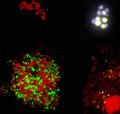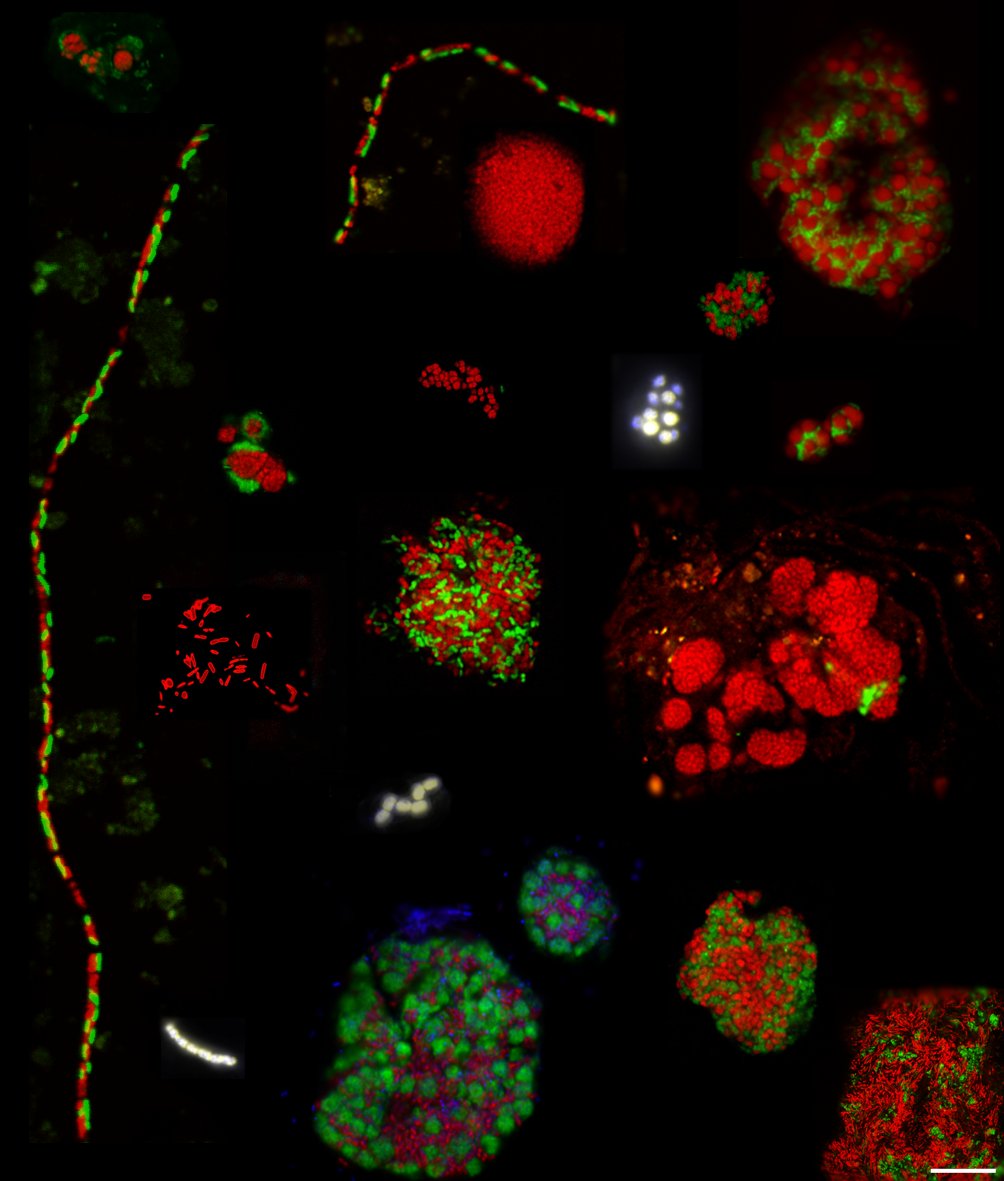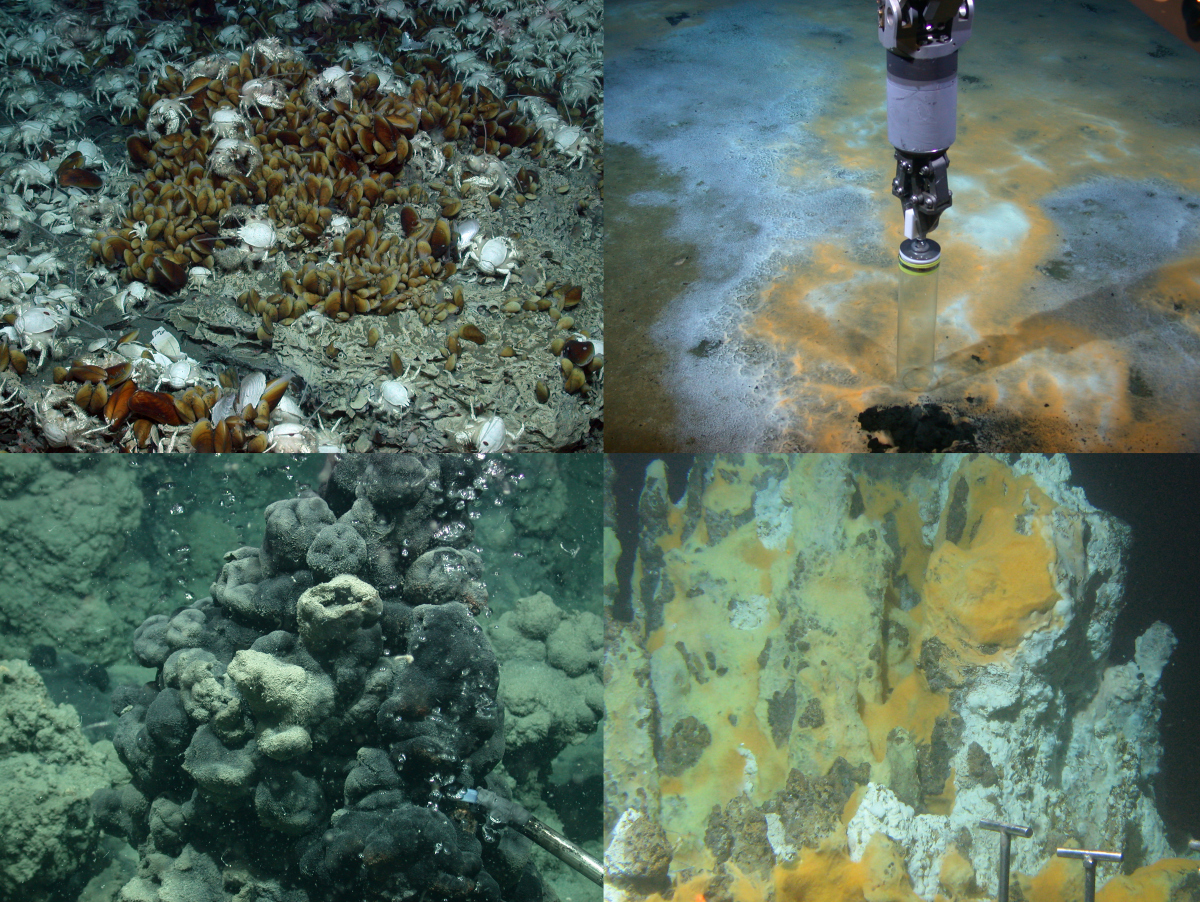Page path:
- Press Office
- Press releases 2015
- 17.03.2015 Methane seeps: Oases in the deep sea
17.03.2015 Methane seeps: Oases in the deep sea
Methane seeps: Oases in the deep sea
First global study of microbial communities at gas seeps in the deep sea shows the distribution and diversity of methane-consuming microorganisms. The specific energy source selects for unique microorganisms, which turn these ecosystems into hotspots of diversity in the deep sea.
Methane seeps are places in the ocean, where methane from deep sediment layers escapes the seabed. Specific microorganisms use the potential greenhouse gas as an energy source and thus form the basis for complex ecosystems. Now an international team of researchers led by the Max Planck Institute for Marine Microbiology has investigated the microbial communities of selected methane seeps from all oceans, and compared those to communities of other marine ecosystems. In the current issue of Proceedings of the National Academy of Sciences (USA), the researchers report that methane seeps contain many endemic microorganisms and therefore are hotspots of biodiversity in the deep sea. In general, the seep communities are very different from those of other ecosystems. Only a few species of methanotrophs occur at all seeps worldwide, but these microorganisms seem to greatly influence the methane budget of the ocean.
Seafloor ecosystems have unique inhabitants
Each ecosystem in the deep sea is inhabited by certain microorganisms that can be assigned to the three domains of the tree of life: eukaryotes, archaea and bacteria. Eukaryotes have a nucleus and include all plants, fungi, animals and man. Archaea and bacteria are single cells without a nucleus. The researchers studied the composition and relative abundance of archaea and bacteria at 77 locations of different marine ecosystems, including coastal sediments, deep-sea sediments, black smokers and methane seeps. They extracted the DNA of these organisms from the seabed samples and analyzed it using modern DNA sequencing techniques and mathematical algorithms.
Emil Ruff, scientist at the Max Planck Institute, summarizes: "Almost all of the major groups of archaea and bacteria were present at all examined sites. With increasing resolution, however, the differences between the ecosystems became clearer. At the level of individual species, which are the smallest branches of the tree of life, we found communities that are characteristic for each ecosystem and have a very specific task." These characteristic communities were defined as the methane seep microbiome. The term microbiome is used to describe all microorganisms of a particular ecosystem and their genetic diversity. Such an ecosystem may be a methane seep, or soil or even the human intestine. The head of the research group, Prof. Dr. Antje Boetius, adds: "This study represents the first global view on microbes inhabiting methane seeps. It was enabled by a large international effort, the International Census of Marine Microbes.”
First global study of microbial communities at gas seeps in the deep sea shows the distribution and diversity of methane-consuming microorganisms. The specific energy source selects for unique microorganisms, which turn these ecosystems into hotspots of diversity in the deep sea.
Methane seeps are places in the ocean, where methane from deep sediment layers escapes the seabed. Specific microorganisms use the potential greenhouse gas as an energy source and thus form the basis for complex ecosystems. Now an international team of researchers led by the Max Planck Institute for Marine Microbiology has investigated the microbial communities of selected methane seeps from all oceans, and compared those to communities of other marine ecosystems. In the current issue of Proceedings of the National Academy of Sciences (USA), the researchers report that methane seeps contain many endemic microorganisms and therefore are hotspots of biodiversity in the deep sea. In general, the seep communities are very different from those of other ecosystems. Only a few species of methanotrophs occur at all seeps worldwide, but these microorganisms seem to greatly influence the methane budget of the ocean.
Seafloor ecosystems have unique inhabitants
Each ecosystem in the deep sea is inhabited by certain microorganisms that can be assigned to the three domains of the tree of life: eukaryotes, archaea and bacteria. Eukaryotes have a nucleus and include all plants, fungi, animals and man. Archaea and bacteria are single cells without a nucleus. The researchers studied the composition and relative abundance of archaea and bacteria at 77 locations of different marine ecosystems, including coastal sediments, deep-sea sediments, black smokers and methane seeps. They extracted the DNA of these organisms from the seabed samples and analyzed it using modern DNA sequencing techniques and mathematical algorithms.
Emil Ruff, scientist at the Max Planck Institute, summarizes: "Almost all of the major groups of archaea and bacteria were present at all examined sites. With increasing resolution, however, the differences between the ecosystems became clearer. At the level of individual species, which are the smallest branches of the tree of life, we found communities that are characteristic for each ecosystem and have a very specific task." These characteristic communities were defined as the methane seep microbiome. The term microbiome is used to describe all microorganisms of a particular ecosystem and their genetic diversity. Such an ecosystem may be a methane seep, or soil or even the human intestine. The head of the research group, Prof. Dr. Antje Boetius, adds: "This study represents the first global view on microbes inhabiting methane seeps. It was enabled by a large international effort, the International Census of Marine Microbes.”
Methanotrophic microorganisms of methane seep ecosystems.
Micrographs of aerobic methanotrophic bacteria (white), anaerobic methanotrophic archaea (ANME – red) and sulfate-reducing bacteria (SRB – green) visualized by fluorescence in situ hybridization. ANME and SRB perform the anaerobic oxidation of methane (AOM). AOM is a globally relevant process removing 60 million tons, the mass of ten pyramids of Giza, of the greenhouse gas methane from seafloor sediments each year. Courtesy of Katrin Knittel/Emil Ruff, MPI Bremen.
Micrographs of aerobic methanotrophic bacteria (white), anaerobic methanotrophic archaea (ANME – red) and sulfate-reducing bacteria (SRB – green) visualized by fluorescence in situ hybridization. ANME and SRB perform the anaerobic oxidation of methane (AOM). AOM is a globally relevant process removing 60 million tons, the mass of ten pyramids of Giza, of the greenhouse gas methane from seafloor sediments each year. Courtesy of Katrin Knittel/Emil Ruff, MPI Bremen.
Methane seeps accommodate many specialists
Natural methane seeps (cold seeps) are found worldwide at continental margins. The gas is formed by decomposition processes in the anoxic layers deep down in the sediment, moves upwards and escapes at the seafloor. The uppermost sediment layers harbor methane oxidizers, which consume about three-quarters of the escaping methane. This is equivalent to 60 million tons of carbon per year. At methane seeps, the primary energy source is completely different from those of the surrounding seabed. Thus, like oases in the desert methane sources attract particular organisms. These include groups with known function, such as anaerobic methane-oxidizing archaea (ANME) and sulfate-reducing bacteria (SRB). However, the researchers also found microbial groups on the methane sources with unknown function.
Emil Ruff, first author of the study, said: "It was surprising that microorganisms from seeps that are thousands of miles away in different oceans, are so closely related. Many methane oxidizers and sulfate reducers are sensitive to oxygen. Therefore, it is a mystery how they survive the great distances between the methane seeps." The findings of the researchers suggest that only a few worldwide populations are responsible for the bulk of the methane consumption. The vast diversity of species and the evolution of new species, however, is limited to and can only be found at certain sites. Methane seeps thus contribute greatly to the biodiversity of the deep sea.
Global dispersion and local diversification of the methane seep microbiome. Emil Ruff, Jennifer F. Biddle, Andreas Teske, Katrin Knittel, Antje Boetius, Alban Ramette PNAS 2015.
DOI: 10.1073/pnas.1421865112.
More information
Emil Ruff, Max Plank Institute for Marine Microbiology, Bremen: +49 421 2028 942; [Bitte aktivieren Sie Javascript]
or from the press officer
Manfred Schlösser, Max Plank Institute for Marine Microbiology, Bremen: +49 421 2028 704 [Bitte aktivieren Sie Javascript]
Natural methane seeps (cold seeps) are found worldwide at continental margins. The gas is formed by decomposition processes in the anoxic layers deep down in the sediment, moves upwards and escapes at the seafloor. The uppermost sediment layers harbor methane oxidizers, which consume about three-quarters of the escaping methane. This is equivalent to 60 million tons of carbon per year. At methane seeps, the primary energy source is completely different from those of the surrounding seabed. Thus, like oases in the desert methane sources attract particular organisms. These include groups with known function, such as anaerobic methane-oxidizing archaea (ANME) and sulfate-reducing bacteria (SRB). However, the researchers also found microbial groups on the methane sources with unknown function.
Emil Ruff, first author of the study, said: "It was surprising that microorganisms from seeps that are thousands of miles away in different oceans, are so closely related. Many methane oxidizers and sulfate reducers are sensitive to oxygen. Therefore, it is a mystery how they survive the great distances between the methane seeps." The findings of the researchers suggest that only a few worldwide populations are responsible for the bulk of the methane consumption. The vast diversity of species and the evolution of new species, however, is limited to and can only be found at certain sites. Methane seeps thus contribute greatly to the biodiversity of the deep sea.
Global dispersion and local diversification of the methane seep microbiome. Emil Ruff, Jennifer F. Biddle, Andreas Teske, Katrin Knittel, Antje Boetius, Alban Ramette PNAS 2015.
DOI: 10.1073/pnas.1421865112.
More information
Emil Ruff, Max Plank Institute for Marine Microbiology, Bremen: +49 421 2028 942; [Bitte aktivieren Sie Javascript]
or from the press officer
Manfred Schlösser, Max Plank Institute for Marine Microbiology, Bremen: +49 421 2028 704 [Bitte aktivieren Sie Javascript]
Four methane seeps and their inhabitants
Top left: Mytilid mussels and Galatheid crabs inhabiting carbonate precipitations of a methane seep on the Kongo continental margin. Both, mussels and crabs can only live in this extreme ecosystem because they have symbiotic bacteria that feed their host. These symbionts convert chemical energy into biomass and thus cause ecosystems that are as densely populated as tropical rainforests. Courtesy of MARUM, University Bremen. ROV QUEST; METEOR Expedition M76/3.
Top right: Microbial mat of orange and white sulfide-oxidizing bacteria on the continental margin of Costa Rica. The bacteria grow on sulfidic sediments and form giant filaments that are visible by the naked eye. The sulfide is produced in the underlying sediment by methane-oxidizing, sulfate-reducing microbial communities. The sediment is sampled with a “Pushcore” operated by a submersible. Courtesy of MARUM, University Bremen. dive 207: ROV QUEST; METEOR Expedition M66/2; Bacterial mats
Bottom left: Microbial reefs are found in the anoxic part of the Black Sea. The reefs are up to several meters high and consist of carbonate precipitations caused by microbial activity and biofilms dominated by anaerobic methanotrophic archaea (ANME). The reefs form at the seafloor, where methane escapes from seabed reservoirs, forming streams of gas bubbles. Courtesy of MARUM, University Bremen.
Bottom right: The Guaymas Basin in the Gulf of California is a unique hydrothermal ecosystem where hot fluids formed in the subsurface seep through thick sediment layers. At the sediment surface, mineral precipitation from the vent fluids form extensive mounds and spires which are covered in orange and white mats of giant sulfur-oxidizing bacteria. The handles in the foreground belong to sediment samplers that are deployed using the submersible ALVIN. Courtesy of the Woods Hole Oceanographic Institution (WHOI); Guaymas Basin cruise AT15-56, Andreas Teske."
Top left: Mytilid mussels and Galatheid crabs inhabiting carbonate precipitations of a methane seep on the Kongo continental margin. Both, mussels and crabs can only live in this extreme ecosystem because they have symbiotic bacteria that feed their host. These symbionts convert chemical energy into biomass and thus cause ecosystems that are as densely populated as tropical rainforests. Courtesy of MARUM, University Bremen. ROV QUEST; METEOR Expedition M76/3.
Top right: Microbial mat of orange and white sulfide-oxidizing bacteria on the continental margin of Costa Rica. The bacteria grow on sulfidic sediments and form giant filaments that are visible by the naked eye. The sulfide is produced in the underlying sediment by methane-oxidizing, sulfate-reducing microbial communities. The sediment is sampled with a “Pushcore” operated by a submersible. Courtesy of MARUM, University Bremen. dive 207: ROV QUEST; METEOR Expedition M66/2; Bacterial mats
Bottom left: Microbial reefs are found in the anoxic part of the Black Sea. The reefs are up to several meters high and consist of carbonate precipitations caused by microbial activity and biofilms dominated by anaerobic methanotrophic archaea (ANME). The reefs form at the seafloor, where methane escapes from seabed reservoirs, forming streams of gas bubbles. Courtesy of MARUM, University Bremen.
Bottom right: The Guaymas Basin in the Gulf of California is a unique hydrothermal ecosystem where hot fluids formed in the subsurface seep through thick sediment layers. At the sediment surface, mineral precipitation from the vent fluids form extensive mounds and spires which are covered in orange and white mats of giant sulfur-oxidizing bacteria. The handles in the foreground belong to sediment samplers that are deployed using the submersible ALVIN. Courtesy of the Woods Hole Oceanographic Institution (WHOI); Guaymas Basin cruise AT15-56, Andreas Teske."


